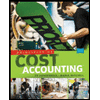
Concept introduction:
Cost Volume Profit (CVP) Analysis:
The Cost Volume Profit analysis is the analysis of the relation between cost, volume, and profit of a product. It analyzes the cost and profits at the different level of production, in order to determine the breakeven point and required the level of sales to earn the desired profit.
Contribution margin means the margin that is left with the company after recovering variable cost out of revenue earned by selling smart phones. The formula for contribution margin is as follows:
Contribution margin = Sales - Variable cost.
Similarly contribution margin ratio = Contribution/sales
Weighted Average Contribution Margin:
Weighted Average Contribution Margin is calculated for two products with the help of following formula:
To calculate:
The weighted Average contribution margin per unit
Want to see the full answer?
Check out a sample textbook solution
Chapter 6 Solutions
Managerial Accounting
- What is the net operating income for Year 3?arrow_forwardI want the correct answer with accountingarrow_forwardChapter:6 Costing - Golden Valley Bakery makes bread using a 4:2:1 ratio of flour, water, and yeast. If one batch requires 350 kg total and flour costs $1.50/kg, water $0.05/kg, and yeast $8/kg, determine the cost per batch.arrow_forward
- Please explain the correct approach for solving this general accounting question.arrow_forwardKahlo Industries uses a predetermined factory overhead rate based on direct labor-hours. For October, Kahlo's budgeted overhead was $180,000 based on a budgeted volume of 15,000 direct labor-hours. Actual overhead amounted to $192,000, with actual direct labor-hours totaling 14,200. Required: What was over- or underapplied manufacturing overhead in October?arrow_forwardI am looking for the correct answer to this general accounting problem using valid accounting standards.arrow_forward
 Principles of Cost AccountingAccountingISBN:9781305087408Author:Edward J. Vanderbeck, Maria R. MitchellPublisher:Cengage Learning
Principles of Cost AccountingAccountingISBN:9781305087408Author:Edward J. Vanderbeck, Maria R. MitchellPublisher:Cengage Learning Survey of Accounting (Accounting I)AccountingISBN:9781305961883Author:Carl WarrenPublisher:Cengage LearningPrinciples of Accounting Volume 2AccountingISBN:9781947172609Author:OpenStaxPublisher:OpenStax College
Survey of Accounting (Accounting I)AccountingISBN:9781305961883Author:Carl WarrenPublisher:Cengage LearningPrinciples of Accounting Volume 2AccountingISBN:9781947172609Author:OpenStaxPublisher:OpenStax College


